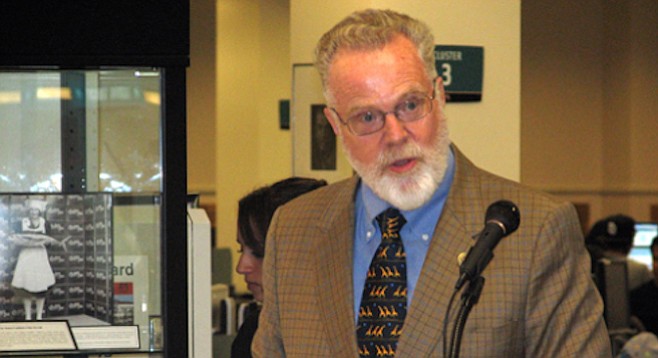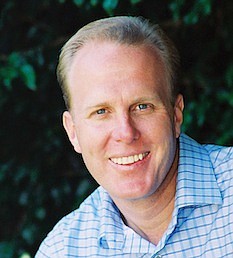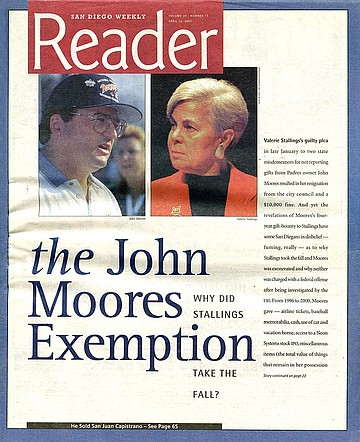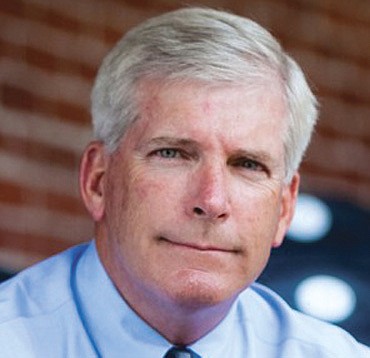 Facebook
Facebook
 X
X
 Instagram
Instagram
 TikTok
TikTok
 Youtube
Youtube

Taxpayers eager for information on the behind-the-scenes machinations regarding a downtown Chargers stadium and expanding San Diego State University to Mission Valley will have to fork over at least $35 for the privilege.
That's the message from SDSU's Corky McMillin Center for Real Estate via an online announcement of an April 5 event at Montezuma Hall entitled, "A New Vision for SDSU: JMI Unveils Its West Campus and Stadium Plan."
"Now, as the Chargers work to develop a downtown San Diego football stadium, the JMI team (represented by President John Kratzer and Steve Peace), working in concert with Steve Black of Cisterra Development, another prominent San Diego developer (and SDSU alumni), will unveil their proposal to develop the Qualcomm Stadium site into a civic gem that all SDSU alumni and San Diego County residents will claim proudly," says the invitation.
Single tickets cost $35 for early registrants, according to the announcement, with late-comers charged $45.
"This event is organized and presented for the sole purpose of providing information and educating SDSU students, alumni, and the general public about an important real-estate matter facing the local community," notes an accompanying disclaimer.
"The event does not imply any endorsement by San Diego State University."
In the big-money poker game that is the Chargers’ stadium saga, the city-owned Qualcomm site in Mission Valley, lusted after by a host of real estate moguls, has long been the ace of spades.

Last summer, Republican mayor Kevin Faulconer and a city-council majority spent $2.1 million of tax money on an environmental impact report, ostensibly in order to build a new Chargers venue on the Mission Valley site.
A chief selling point was the establishment of rights for high-density office and condo development of the city-owned property.
Faulconer's overtures were spurned by the Chargers, which subsequently lost a bid to build an L.A. stadium with the Oakland Raiders. The team boomeranged back to San Diego, into the arms of ex–Padres owner John Moores and his JMI development company, with a big stake in seeing the team move into a tax-funded stadium adjacent to the real estate it controls downtown.
Though Moores and his representatives have maintained that his interest in the Mission Valley Qualcomm site is purely charitable, skeptics note that the Rancho Santa Fe denizen has previously scored major commercial points with his philanthropy, especially through his San Diego State connections.
Back in the mid-1990s, as Moores sought political support for his tax-funded Padres ballpark, he lavished SDSU with cash for its athletic programs, yielding for him the sizable lobbying muscle of then–university president Stephen Weber, who at one point sought to grab a sizable piece of the action.
"This letter is to introduce the concept of a public/private partnership, which would enable the financing and constructing of a baseball stadium for the San Diego Padres," wrote Weber to Moores on December 9, 1997.
"The partnership would be between you and San Diego State University, with whom you have obviously established a history of philanthropy."
Continued Weber, "Such a partnership would require the ability of SDSU to link our educational mission with the ownership/operation of a baseball stadium. We believe that challenge might be met in a variety of ways, most significantly with the possibility that SDSU would establish an educational center with programs and curricula meeting regional educational needs in the fields of sports management, hospitality and hotel/restaurant management."
The SDSU president went on to solicit Moores for more money, adding, "With this contribution, and assuming naming-rights revenue and sufficient operating income, SDSU would seek to purchase a site and secure construction financing either as a governmental agency, through one of our existing nonprofit corporations, or through a newly established nonprofit."
Weber posited that the university could offer Moores big tax breaks to make the deal financially attractive.
"The partnership also assumes that whatever personal stake you intend to contribute to the baseball stadium is significantly stretched by the multiple tax advantages associated with a charitable contribution."
Asserted Weber, "Under such a scenario, a public vote would not be required."
The deal did not come to pass, and state taxpayers were off the hook.
Not so residents of the city of San Diego, who ultimately wound up subsidizing a major portion of the ballpark tab, paying about $12 million a year in debt service, according to this year's city budget documents.

Subsequently beset by scandals involving gifts to city councilwoman Valerie Stallings — forced from office in 2001 — and his troubled Peregrine Systems, Moores adopted a lower profile.
“Look, take my name off stuff. I don’t want my name used in affiliation with the university if it’s going to be a lightning rod for controversy,” then–Padres vice chairman Bob Vizas quoted Moores as saying as Peregrine went bankrupt and a top executive went to prison related to massive fraud by the company.
Moores has since continued to maintain a close, if less public, relationship with the university.

After onetime SDSU athletic director Jeff Schemmel was forced to resign in November 2009 following revelations he had used tax dollars to visit his alleged mistress in Alabama, Moores hired him as managing director of JMI Sports, a subsidiary of the Moores empire that describes itself as "a fully integrated management and consulting firm that provides comprehensive services to the sports marketplace."


Taxpayers eager for information on the behind-the-scenes machinations regarding a downtown Chargers stadium and expanding San Diego State University to Mission Valley will have to fork over at least $35 for the privilege.
That's the message from SDSU's Corky McMillin Center for Real Estate via an online announcement of an April 5 event at Montezuma Hall entitled, "A New Vision for SDSU: JMI Unveils Its West Campus and Stadium Plan."
"Now, as the Chargers work to develop a downtown San Diego football stadium, the JMI team (represented by President John Kratzer and Steve Peace), working in concert with Steve Black of Cisterra Development, another prominent San Diego developer (and SDSU alumni), will unveil their proposal to develop the Qualcomm Stadium site into a civic gem that all SDSU alumni and San Diego County residents will claim proudly," says the invitation.
Single tickets cost $35 for early registrants, according to the announcement, with late-comers charged $45.
"This event is organized and presented for the sole purpose of providing information and educating SDSU students, alumni, and the general public about an important real-estate matter facing the local community," notes an accompanying disclaimer.
"The event does not imply any endorsement by San Diego State University."
In the big-money poker game that is the Chargers’ stadium saga, the city-owned Qualcomm site in Mission Valley, lusted after by a host of real estate moguls, has long been the ace of spades.

Last summer, Republican mayor Kevin Faulconer and a city-council majority spent $2.1 million of tax money on an environmental impact report, ostensibly in order to build a new Chargers venue on the Mission Valley site.
A chief selling point was the establishment of rights for high-density office and condo development of the city-owned property.
Faulconer's overtures were spurned by the Chargers, which subsequently lost a bid to build an L.A. stadium with the Oakland Raiders. The team boomeranged back to San Diego, into the arms of ex–Padres owner John Moores and his JMI development company, with a big stake in seeing the team move into a tax-funded stadium adjacent to the real estate it controls downtown.
Though Moores and his representatives have maintained that his interest in the Mission Valley Qualcomm site is purely charitable, skeptics note that the Rancho Santa Fe denizen has previously scored major commercial points with his philanthropy, especially through his San Diego State connections.
Back in the mid-1990s, as Moores sought political support for his tax-funded Padres ballpark, he lavished SDSU with cash for its athletic programs, yielding for him the sizable lobbying muscle of then–university president Stephen Weber, who at one point sought to grab a sizable piece of the action.
"This letter is to introduce the concept of a public/private partnership, which would enable the financing and constructing of a baseball stadium for the San Diego Padres," wrote Weber to Moores on December 9, 1997.
"The partnership would be between you and San Diego State University, with whom you have obviously established a history of philanthropy."
Continued Weber, "Such a partnership would require the ability of SDSU to link our educational mission with the ownership/operation of a baseball stadium. We believe that challenge might be met in a variety of ways, most significantly with the possibility that SDSU would establish an educational center with programs and curricula meeting regional educational needs in the fields of sports management, hospitality and hotel/restaurant management."
The SDSU president went on to solicit Moores for more money, adding, "With this contribution, and assuming naming-rights revenue and sufficient operating income, SDSU would seek to purchase a site and secure construction financing either as a governmental agency, through one of our existing nonprofit corporations, or through a newly established nonprofit."
Weber posited that the university could offer Moores big tax breaks to make the deal financially attractive.
"The partnership also assumes that whatever personal stake you intend to contribute to the baseball stadium is significantly stretched by the multiple tax advantages associated with a charitable contribution."
Asserted Weber, "Under such a scenario, a public vote would not be required."
The deal did not come to pass, and state taxpayers were off the hook.
Not so residents of the city of San Diego, who ultimately wound up subsidizing a major portion of the ballpark tab, paying about $12 million a year in debt service, according to this year's city budget documents.

Subsequently beset by scandals involving gifts to city councilwoman Valerie Stallings — forced from office in 2001 — and his troubled Peregrine Systems, Moores adopted a lower profile.
“Look, take my name off stuff. I don’t want my name used in affiliation with the university if it’s going to be a lightning rod for controversy,” then–Padres vice chairman Bob Vizas quoted Moores as saying as Peregrine went bankrupt and a top executive went to prison related to massive fraud by the company.
Moores has since continued to maintain a close, if less public, relationship with the university.

After onetime SDSU athletic director Jeff Schemmel was forced to resign in November 2009 following revelations he had used tax dollars to visit his alleged mistress in Alabama, Moores hired him as managing director of JMI Sports, a subsidiary of the Moores empire that describes itself as "a fully integrated management and consulting firm that provides comprehensive services to the sports marketplace."
Comments